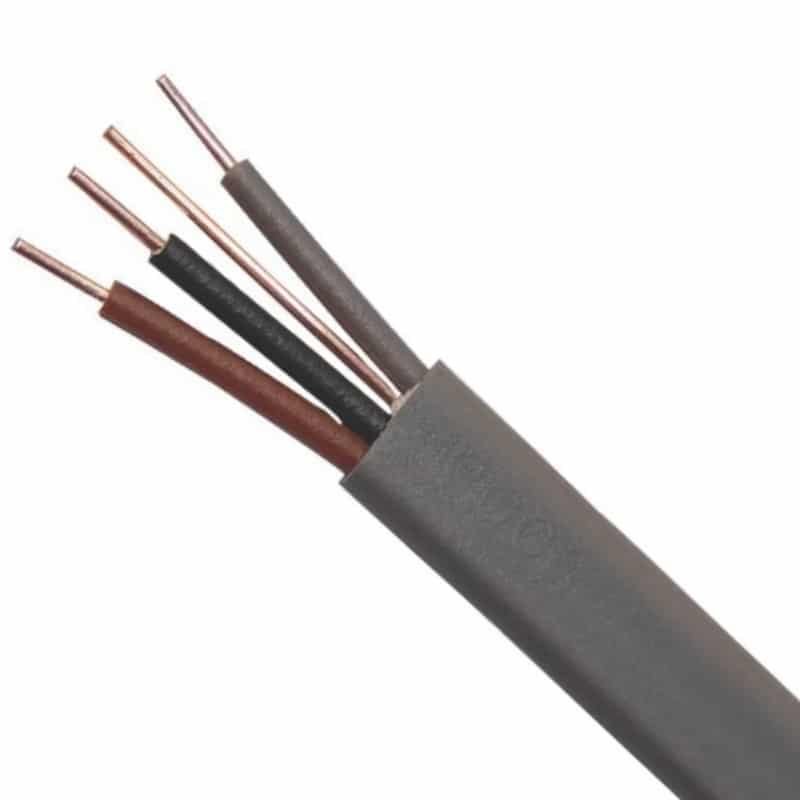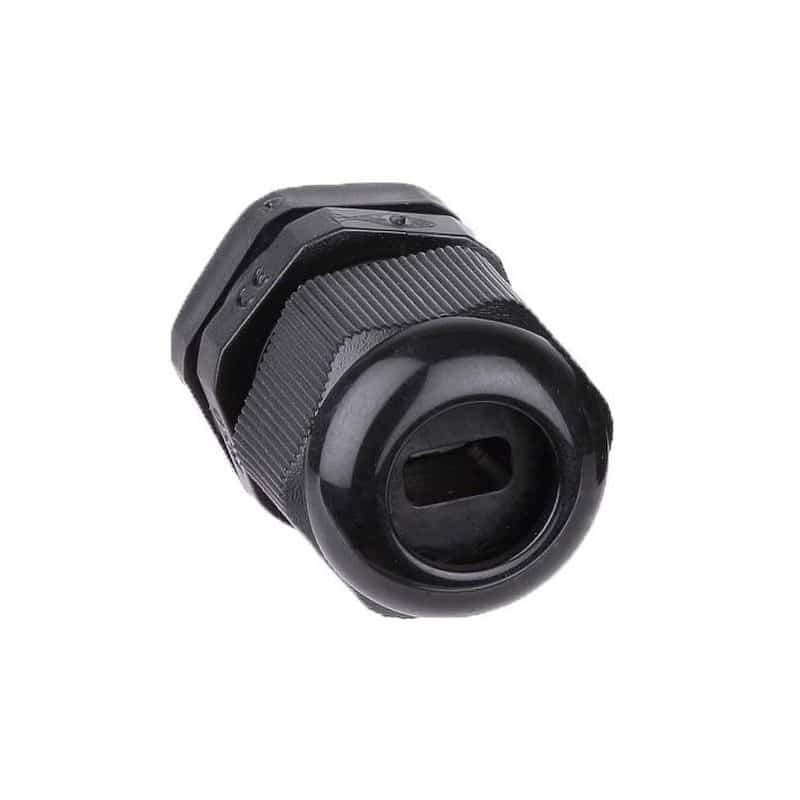Standard round cable glands won’t work with flat ribbon cables, leaving critical connections exposed and vulnerable. Flat cables require specialized sealing solutions that maintain IP protection while accommodating unique cable geometries.
Flat cable glands provide secure, waterproof sealing for ribbon cables, flat flex cables1, and multi-conductor flat assemblies – ensuring reliable connections in space-constrained applications where traditional round glands simply won’t fit.
Last month, David called me in a panic. His team had spent weeks designing a control panel, only to discover their flat ribbon cables couldn’t be properly sealed with standard glands. “Chuck, we need a solution yesterday!” That’s when I introduced him to our flat cable gland technology 😉
Table of Contents
- What Are Flat Cable Glands and How Do They Differ from Standard Glands?
- Which Applications Require Flat Cable Glands?
- How Do You Select the Right Flat Cable Gland?
- What Are the Installation Best Practices for Flat Cable Glands?
What Are Flat Cable Glands and How Do They Differ from Standard Glands?
Ever tried to force a flat ribbon cable through a round hole? It doesn’t work.
Flat cable glands feature specialized oval or rectangular sealing chambers designed to accommodate flat cable profiles while maintaining IP65-IP68 protection through custom-molded sealing elements that conform to the cable’s flat geometry.

Key Design Differences
Traditional Round Glands vs. Flat Cable Glands
| Feature | Round Glands | Flat Cable Glands |
|---|---|---|
| Sealing Chamber | Circular | Oval/Rectangular |
| Cable Compatibility | Round cables only | Flat ribbon, flex cables |
| Sealing Method | Radial compression | Planar compression2 |
| Space Requirements | Standard mounting | Compact profile |
Our Flat Cable Gland Technologies
Type 1: Ribbon Cable Glands
- Cable Range: 0.5mm to 3mm thickness
- Width Capacity: Up to 50mm wide
- Materials: Nylon PA66, TPE sealing elements
- IP Rating: IP65-IP67
Type 2: Flat Flex Cable Glands
- Applications: FFC/FPC connections
- Thickness Range: 0.1mm to 1.5mm
- Sealing Technology: Dual-layer compression
- Certifications: UL94-V03, RoHS compliant
Type 3: Multi-Conductor Flat Assemblies
- Cable Types: Flat multi-core cables
- Conductor Count: Up to 50 conductors
- Shielding: EMC versions available
- Temperature Range: -40°C to +100°C
Advanced Sealing Mechanisms
The secret is in our progressive compression system:
- Primary Seal: TPE gasket conforms to cable surface
- Secondary Seal: O-ring provides enclosure sealing
- Strain Relief: Integrated cable support prevents pull-out
- EMC Shielding: Optional 360° EMC continuity
Hassan, a chemical plant owner, was amazed when I showed him how our flat glands could seal his control cables while maintaining ATEX certification. “Chuck, this solves our space problem and keeps our safety ratings!”
Which Applications Require Flat Cable Glands?
Think flat cables are just for consumer electronics? Think bigger.
Industrial automation, automotive systems, medical devices, and renewable energy installations increasingly use flat cables for space efficiency, requiring specialized glands that standard round solutions cannot accommodate.
Primary Application Sectors
Industrial Automation & Control
- Servo motor feedback cables: Encoder ribbons, resolver connections
- HMI panel connections: Touch screen flat flex cables
- PLC I/O modules: High-density flat ribbon assemblies
- Robot arm wiring: Flexible flat cables for moving joints
Automotive & Transportation
- Dashboard electronics: Flat flex PCB interconnects
- Door control modules: Window, lock, mirror flat cables
- Battery management: EV flat bus bar4 connections
- Sensor networks: Automotive flat ribbon harnesses
Medical & Laboratory Equipment
- Imaging systems: Flat detector cables, scanner ribbons
- Patient monitoring: ECG, EEG flat electrode cables
- Surgical instruments: Endoscope flat video cables
- Laboratory automation: Analyzer flat data cables
Real-World Case Studies
Case Study 1 – David’s Automation Challenge:
A UK packaging machinery manufacturer needed to connect 40 I/O signals through a small panel opening. Standard round glands would require 40 separate holes. Our custom flat ribbon gland accommodated all 40 conductors in a single M25 opening, saving 75% of panel space.
Case Study 2 – Solar Installation Project:
A solar farm in Spain used flat DC bus cables between inverters. Traditional glands couldn’t seal the 10mm x 50mm flat conductors. Our specialized flat cable glands provided IP68 protection while handling 1000V DC ratings.
Space-Critical Applications
| Application | Space Saved | Traditional Solution | Flat Gland Solution |
|---|---|---|---|
| 20-conductor control | 80% | 20 x M12 glands | 1 x M25 flat gland |
| HMI touch panel | 90% | Multiple round entries | Single flat entry |
| Servo feedback | 60% | 4 x M16 glands | 1 x M20 flat gland |
How Do You Select the Right Flat Cable Gland?
Choosing wrong means compromising either sealing or cable integrity.
Select flat cable glands based on cable dimensions, environmental requirements, and electrical specifications – measure cable thickness and width precisely, then match to gland capacity while ensuring adequate IP rating for your application environment.
Selection Criteria Matrix
Step 1: Cable Measurement
- Thickness (T): Measure with calipers, add 10% tolerance
- Width (W): Include any shielding or jacketing
- Flexibility: Consider bend radius requirements
- Temperature Rating: Match cable and gland specifications
Step 2: Environmental Assessment
- IP Rating Required: Indoor (IP54), Outdoor (IP65+), Submersible (IP68)
- Chemical Exposure: Acids, oils, cleaning agents
- Temperature Range: Operating and storage conditions
- UV Exposure: Outdoor installations require UV-stable materials
Step 3: Electrical Requirements
- Voltage Rating: Match or exceed cable voltage
- Current Capacity: Ensure adequate heat dissipation
- EMC Shielding: Required for sensitive electronics
- Safety Certifications: UL, CE, ATEX as needed
Our Product Selection Guide
For Standard Industrial Applications
Nylon Flat Cable Glands
- Cable Range: 1-3mm thick, up to 30mm wide
- IP Rating: IP65
- Temperature: -20°C to +80°C
- Price: $25-$45
For Harsh Environment Applications
Stainless Steel Flat Glands
- Cable Range: 0.5-5mm thick, up to 50mm wide
- IP Rating: IP68
- Temperature: -40°C to +120°C
- Certifications: ATEX, Marine DNV-GL5
- Price: $75-$150
For High-Performance Electronics
EMC Flat Cable Glands
- Shielding Effectiveness: >60dB (10MHz-1GHz)
- Cable Range: 0.5-2mm thick, up to 25mm wide
- Materials: Nickel-plated brass, conductive gaskets
- Price: $60-$120
Custom Solutions Available
David once asked me: “Chuck, what if our cable doesn’t fit any standard size?” That’s where our engineering team shines. We can custom-mold sealing elements for virtually any flat cable profile. Minimum order quantities apply, but for critical applications, it’s often the only solution.
What Are the Installation Best Practices for Flat Cable Glands?
Poor installation turns the best gland into a water entry point.
Install flat cable glands with proper cable preparation, correct torque sequences, and appropriate sealing orientation – the flat profile requires special attention to prevent cable damage and ensure reliable sealing performance.
Pre-Installation Preparation
Cable Preparation Checklist
- Strip Length: Follow gland specifications exactly
- Edge Finishing: Remove sharp edges that could cut seals
- Conductor Arrangement: Maintain flat profile, avoid twisting
- Shield Termination: Properly terminate braided shields
- Jacket Integrity: Inspect for nicks or damage
Panel Preparation
- Hole Size: Use step drill for clean, precise openings
- Edge Deburring: Remove all sharp edges from panel hole
- Surface Cleaning: Ensure gasket sealing surfaces are clean
- Thread Inspection: Check for complete, undamaged threads
Installation Sequence
Step-by-Step Process
- Dry Fit Test: Verify cable fits through gland without force
- Apply Thread Sealant: Use appropriate compound for environment
- Insert Cable: Maintain flat orientation, avoid twisting
- Position Sealing Elements: Ensure proper alignment with cable
- Hand Tighten: Secure gland body to panel
- Compress Seals: Tighten compression nut to specification
- Final Torque: Use torque wrench for consistent results
Critical Installation Parameters
| Gland Size | Panel Hole | Torque Spec | Compression |
|---|---|---|---|
| M16 Flat | 16.2mm | 15 Nm | 2-3mm |
| M20 Flat | 20.2mm | 20 Nm | 2-4mm |
| M25 Flat | 25.2mm | 25 Nm | 3-5mm |
| M32 Flat | 32.2mm | 30 Nm | 3-6mm |
Common Installation Errors
Error 1: Over-Compression
Problem: Crushing flat cables, damaging conductors
Solution: Follow compression specifications, use depth gauge
Error 2: Cable Twisting
Problem: Breaking sealing integrity, conductor damage
Solution: Maintain cable orientation throughout installation
Error 3: Inadequate Strain Relief
Problem: Cable pull-out, connection failure
Solution: Use proper cable support within 150mm of gland
Testing and Validation
After installation, Hassan always asks me: “Chuck, how do we know it’s properly sealed?” Here’s our recommended test procedure:
- Visual Inspection: Check seal compression, cable alignment
- Continuity Test: Verify all conductors intact
- Insulation Test: Confirm no conductor-to-shield shorts
- Pressure Test: If required, test to IP rating specification
- Pull Test: Gentle tug to confirm strain relief engagement
Maintenance Considerations
Good news: Properly installed flat cable glands require minimal maintenance. However, in high-vibration applications, annual retorque checks are recommended. The flat cable profile actually provides better strain relief than round cables due to increased surface contact area.
Conclusion
Flat cable glands solve unique sealing challenges that standard round glands cannot address, enabling space-efficient designs while maintaining environmental protection standards.
FAQs About Flat Cable Glands
Q: Can flat cable glands accommodate different cable thicknesses?
A: Yes, our flat cable glands feature adjustable sealing elements that accommodate thickness variations of ±20% from nominal specifications. The TPE sealing material compresses to fit cable variations while maintaining IP protection.
Q: What’s the maximum width flat cable that can be sealed?
A: Our largest flat cable glands can accommodate cables up to 75mm wide with thicknesses from 0.5mm to 8mm. For wider applications, we offer custom solutions with minimum order quantities.
Q: Are flat cable glands suitable for outdoor installations?
A: Absolutely. Our outdoor-rated flat cable glands provide IP65-IP68 protection with UV-stable materials. Stainless steel versions are available for marine and chemical environments with full ATEX certification.
Q: How do flat cable glands handle cable movement and vibration?
A: Flat cable glands actually provide superior strain relief compared to round glands due to increased contact surface area. The flat profile distributes stress more evenly, reducing conductor fatigue in dynamic applications.
Q: Can EMC shielding be maintained through flat cable glands?
A: Yes, our EMC flat cable glands provide 360° shielding continuity with >60dB effectiveness from 10MHz to 1GHz. Conductive gaskets and nickel-plated housings ensure reliable EMC performance in sensitive electronic applications.
-
Learn about the construction and applications of Flat Flex Cables (FFC) and Flat Printed Circuits (FPC). ↩
-
Understand the mechanical principles of planar compression and how it differs from radial compression seals. ↩
-
Review the UL94 standard for plastics flammability and understand what the V-0 rating signifies. ↩
-
Discover the function and types of bus bars used for high-current power distribution. ↩
-
Learn about the DNV certification body and its standards for the maritime and energy industries. ↩



